- 10-orthoplex
-
10-orthoplex
Decacross
Orthogonal projection
inside Petrie polygonType Regular 10-polytope Family orthoplex Schläfli symbol {38,4}
{37,1,1}Coxeter-Dynkin diagrams 



































9-faces 1024 {38} 
8-faces 5120 {37} 
7-faces 11520 {36} 
6-faces 15360 {35} 
5-faces 13440 {34} 
4-faces 8064 {33} 
Cells 3360 {3,3} 
Faces 960 {3} 
Edges 180 Vertices 20 Vertex figure 9-orthoplex Petrie polygon Icosagon Coxeter groups C10, [38,4]
D10, [37,1,1]Dual 10-cube Properties convex In geometry, a 10-orthoplex or 10-cross polytope, is a regular 10-polytope with 20 vertices, 180 edges, 960 triangle faces, 3360 octahedron cells, 8064 5-cells 4-faces, 13440 5-faces, 15360 6-faces, 11520 7-faces, 5120 8-faces, and 1024 9-faces.
It has two constructed forms, the first being regular with Schläfli symbol {38,4}, and the second with alternately labeled (checkerboarded) facets, with Schläfli symbol {37,1,1} or Coxeter symbol 711.
Contents
Alternate names
- Decacross is derived from combining the family name cross polytope with deca for ten (dimensions) in Greek
- Chilliaicositetra-xennon as a 1024-facetted 10-polytope (polyxennon).
Related polytopes
It is one of an infinite family of polytopes, called cross-polytopes or orthoplexes. The dual polytope is the 10-hypercube or 10-cube.
Construction
There are two Coxeter groups associated with the 10-orthoplex, one regular, dual of the 10-cube with the C10 or [4,38] symmetry group, and a lower symmetry with two copies of 9-simplex facets, alternating, with the D10 or [37,1,1] symmetry group.
Cartesian coordinates
Cartesian coordinates for the vertices of a 10-orthoplex, centered at the origin are
- (±1,0,0,0,0,0,0,0,0,0), (0,±1,0,0,0,0,0,0,0,0), (0,0,±1,0,0,0,0,0,0,0), (0,0,0,±1,0,0,0,0,0,0), (0,0,0,0,±1,0,0,0,0,0), (0,0,0,0,0,±1,0,0,0,0), (0,0,0,0,0,0,±1,0,0,0), (0,0,0,0,0,0,0,±1,0,0), (0,0,0,0,0,0,0,0,±1,0), (0,0,0,0,0,0,0,0,0,±1)
Every vertex pair is connected by an edge, except opposites.
Images
orthographic projections B10 B9 B8 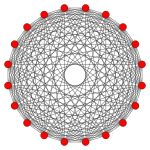
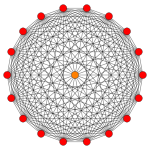
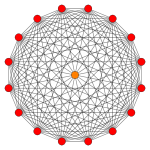
[20] [18] [16] B7 B6 B5 

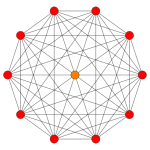
[14] [12] [10] B4 B3 B2 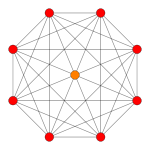

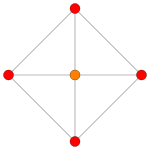
[8] [6] [4] References
- H.S.M. Coxeter:
- H.S.M. Coxeter, Regular Polytopes, 3rd Edition, Dover New York, 1973
- Kaleidoscopes: Selected Writings of H.S.M. Coxeter, editied by F. Arthur Sherk, Peter McMullen, Anthony C. Thompson, Asia Ivic Weiss, Wiley-Interscience Publication, 1995, ISBN 978-0-471-01003-6 [1]
- (Paper 22) H.S.M. Coxeter, Regular and Semi Regular Polytopes I, [Math. Zeit. 46 (1940) 380-407, MR 2,10]
- (Paper 23) H.S.M. Coxeter, Regular and Semi-Regular Polytopes II, [Math. Zeit. 188 (1985) 559-591]
- (Paper 24) H.S.M. Coxeter, Regular and Semi-Regular Polytopes III, [Math. Zeit. 200 (1988) 3-45]
- Norman Johnson Uniform Polytopes, Manuscript (1991)
- N.W. Johnson: The Theory of Uniform Polytopes and Honeycombs, Ph.D. (1966)
- Richard Klitzing, 10D uniform polytopes (polyxenna), x3o3o3o3o3o3o3o3o4o - ka
External links
- Olshevsky, George, Cross polytope at Glossary for Hyperspace.
- Polytopes of Various Dimensions
- Multi-dimensional Glossary
Fundamental convex regular and uniform polytopes in dimensions 2–10 Family An BCn Dn E6 / E7 / E8 / F4 / G2 Hn Regular polygon Triangle Square Hexagon Pentagon Uniform polyhedron Tetrahedron Octahedron • Cube Demicube Dodecahedron • Icosahedron Uniform polychoron 5-cell 16-cell • Tesseract Demitesseract 24-cell 120-cell • 600-cell Uniform 5-polytope 5-simplex 5-orthoplex • 5-cube 5-demicube Uniform 6-polytope 6-simplex 6-orthoplex • 6-cube 6-demicube 122 • 221 Uniform 7-polytope 7-simplex 7-orthoplex • 7-cube 7-demicube 132 • 231 • 321 Uniform 8-polytope 8-simplex 8-orthoplex • 8-cube 8-demicube 142 • 241 • 421 Uniform 9-polytope 9-simplex 9-orthoplex • 9-cube 9-demicube Uniform 10-polytope 10-simplex 10-orthoplex • 10-cube 10-demicube n-polytopes n-simplex n-orthoplex • n-cube n-demicube 1k2 • 2k1 • k21 pentagonal polytope Topics: Polytope families • Regular polytope • List of regular polytopes 
This geometry-related article is a stub. You can help Wikipedia by expanding it.
